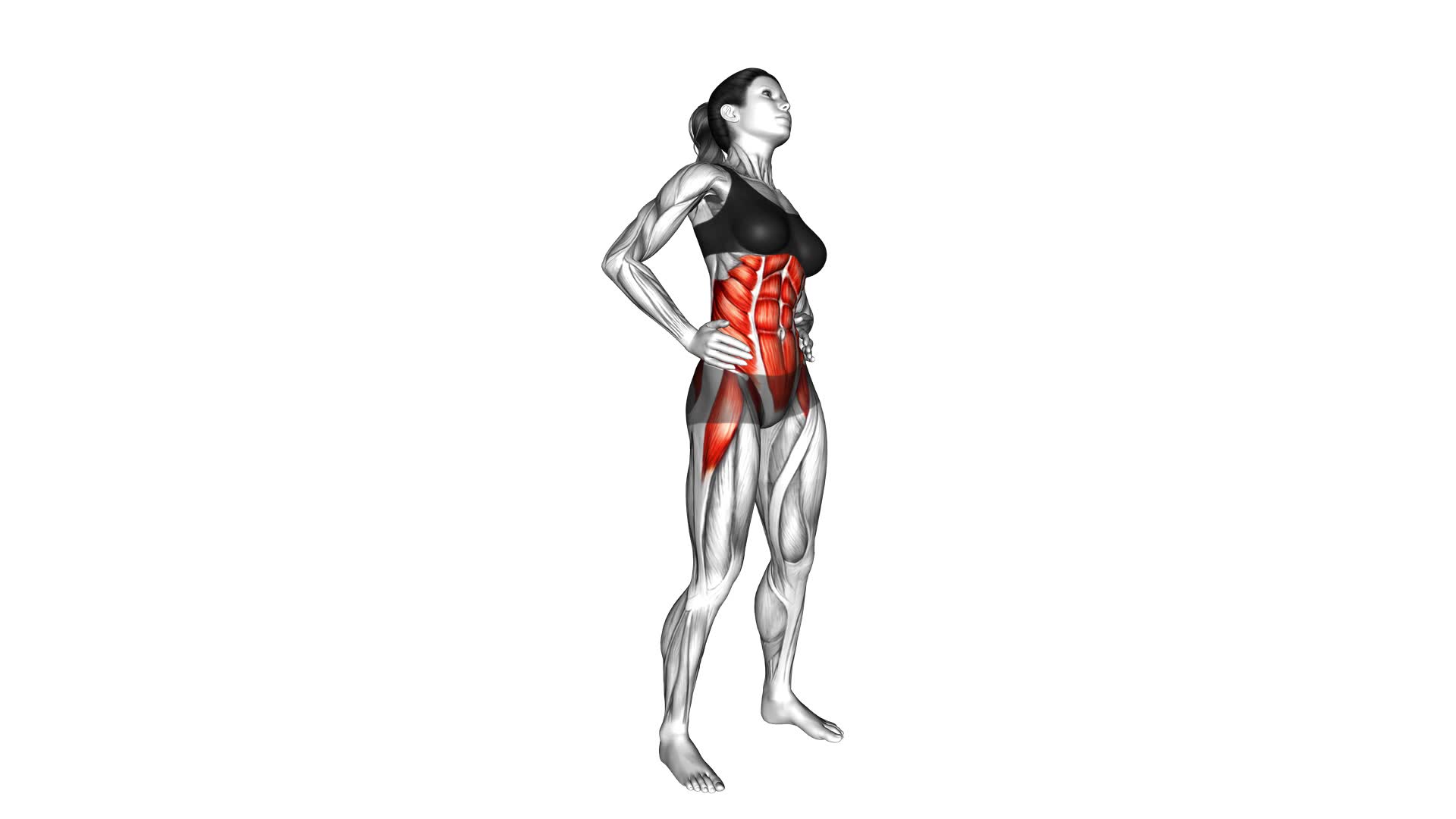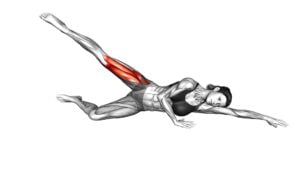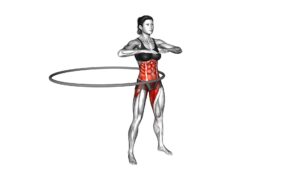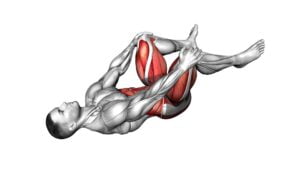Standing Hip Circle (female) – Video Exercise Guide & Tips

Are you looking to tone your hips and strengthen your core? The Standing Hip Circle is the perfect exercise for you! In this video exercise guide, we'll show you the proper form and technique to maximize your results.
Watch This Exercise Video
Plus, we'll give you variations and modifications to suit your fitness level. Avoid common mistakes and get expert tips on how to incorporate the Standing Hip Circle into your workout routine.
Let's get started!
Key Takeaways
- The standing hip circle enhances hip mobility and improves overall hip flexibility and range of motion.
- It strengthens the glutes, hip flexors, and hip abductors, while also improving posture and stability.
- The exercise increases core strength and balance.
- Variations and modifications, such as using resistance bands or performing circles on an unstable surface, can add challenge and intensity to the exercise.
Benefits of the Standing Hip Circle
To experience the full benefits of the Standing Hip Circle, you should focus on engaging your core and activating your hip muscles. This exercise is one of the most effective hip mobility exercises that can help improve your overall hip flexibility and range of motion. By incorporating the Standing Hip Circle into your routine, you can strengthen the muscles surrounding your hips, including the glutes, hip flexors, and hip abductors.
One of the key benefits of the Standing Hip Circle is its ability to enhance hip mobility. As we age, our hip joints tend to become stiff and less flexible, which can lead to discomfort and limited movement. By regularly performing the Standing Hip Circle, you can improve the mobility of your hip joints, allowing you to move more freely and with greater ease.
Additionally, the Standing Hip Circle can also help to improve your posture and stability. By engaging your core muscles throughout the exercise, you can strengthen your core and improve your overall balance. This can be particularly beneficial for individuals who experience lower back pain or have poor posture.
Proper Form and Technique
Focus on maintaining proper form and technique while performing the Standing Hip Circle exercise. This won't only ensure you get the most out of the exercise, but also help prevent injuries.
Here are some key tips to keep in mind:
- Stand tall with your feet hip-width apart and engage your core muscles.
- Begin by shifting your weight onto your right leg and slightly bending your left knee.
- Slowly circle your left hip in a clockwise motion, making sure to keep your pelvis stable and your upper body still.
- Repeat the movement for the desired number of repetitions and then switch to the other side.
By focusing on proper form and technique, you can maximize the benefits of the Standing Hip Circle exercise. This exercise is great for improving balance and strengthening the hip muscles. The controlled circular motion helps to activate and engage the glutes, hip flexors, and abductors. It also promotes stability and mobility in the hip joint.
Remember to start with a lighter resistance band or no band at all, and gradually increase the resistance as you become more comfortable and confident with the exercise.
Variations and Modifications
Try different variations and modifications of the Standing Hip Circle exercise to target different muscles and add variety to your workout routine. By incorporating standing hip circle modifications and advanced hip circle variations, you can challenge your body in new ways and keep your workouts interesting.
To modify the standing hip circle, you can use resistance bands or ankle weights to add an extra challenge. These modifications increase the resistance and engage your muscles more intensely. Another modification is to perform the exercise on an unstable surface, such as a balance board or BOSU ball. This will require you to engage your core muscles even more to maintain stability.
For advanced hip circle variations, you can try performing the exercise with a medicine ball or kettlebell. Holding the weight in front of you as you perform the circles will further engage your core and upper body muscles. Another advanced variation is to perform the circles in a squat position or on one leg. These variations will increase the intensity and challenge your balance and stability.
Common Mistakes to Avoid
One common mistake to avoid when performing the standing hip circle exercise is failing to maintain proper form and technique. To ensure that you get the most out of this exercise and minimize the risk of injury, here are some common mistakes to watch out for:
- Allowing your upper body to sway: It's important to keep your upper body stable and avoid any excessive movement. Engage your core muscles and maintain an upright posture throughout the exercise.
- Not engaging your glutes: The standing hip circle primarily targets the glute muscles. To activate them effectively, focus on squeezing your glutes as you perform the movement. This will help to maximize the benefits of the exercise.
- Using momentum instead of control: The hip circle should be performed in a slow and controlled manner. Avoid swinging your hips or relying on momentum to complete the movement. Instead, focus on using your muscles to initiate and control the circular motion.
Tips for Incorporating the Standing Hip Circle Into Your Workout Routine
To incorporate the standing hip circle into your workout routine, start by adding it as a dynamic warm-up exercise. This will help to increase blood flow to the muscles and prepare them for the upcoming workout.
Begin by standing with your feet shoulder-width apart and your hands on your hips. Next, slowly start to circle your hips in a clockwise direction, making sure to engage your core and keep your upper body stable. After completing a few circles in one direction, switch to counterclockwise circles. Aim to perform 10 to 12 circles in each direction.
In addition to using the standing hip circle as a warm-up exercise, you can also incorporate it into your adductor exercises and hip mobility exercises. When performing adductor exercises such as standing side leg lifts or sumo squats, you can add the hip circle movement to further engage the inner thigh muscles. Similarly, when working on hip mobility exercises like hip circles or hip rotations, incorporating the standing hip circle can help to enhance the range of motion in the hips.
Remember to start with smaller circles and gradually increase the size as you feel more comfortable and confident with the movement.
Frequently Asked Questions
How Many Repetitions of the Standing Hip Circle Should I Do?
To get the most out of the standing hip circle exercise, it's important to know how many repetitions to do.
The benefits of this exercise include strengthening your hip muscles and improving flexibility.
To perform it correctly, stand with your feet shoulder-width apart and circle your hips in a smooth and controlled motion.
As for the number of repetitions, start with 10-15 on each side and gradually increase as you become more comfortable and stronger.
Listen to your body and adjust accordingly.
Can Men Also Benefit From Doing the Standing Hip Circle Exercise?
Yes, men can also benefit from doing the standing hip circle exercise. It's a great exercise for improving hip mobility and strengthening the core muscles.
However, if you're looking for alternative exercises, there are plenty of options available. You can try exercises like squats, lunges, or deadlifts, which also target the hip muscles and provide similar benefits for men's fitness.
It's important to choose exercises that align with your fitness goals and preferences.
Is It Safe to Do the Standing Hip Circle Exercise if I Have a History of Hip Injuries?
If you have a history of hip injuries, it's important to consider modifications for the standing hip circle exercise. It may be best to consult with a healthcare professional or a qualified fitness trainer who can provide guidance on how to adapt the exercise to avoid any potential strain or aggravation.
Additionally, there are alternative exercises that can target similar muscle groups without putting excessive stress on the hips. Exploring these alternatives can help you maintain a safe and effective workout routine.
Can the Standing Hip Circle Help Improve Flexibility in the Hips?
Yes, the standing hip circle can help improve flexibility in your hips. By incorporating this exercise into your routine, you can enhance hip mobility and prevent future hip injuries.
The circular motion engages the muscles around your hips, increasing their range of motion and flexibility. It's important to perform this exercise correctly and gradually increase intensity to avoid any strain or injury.
Make sure to consult with a fitness professional or your doctor if you have any concerns or prior hip injuries.
Will Doing the Standing Hip Circle Exercise Help Me Lose Weight in My Hips and Thighs?
Doing the standing hip circle exercise can be beneficial for your hips and thighs. It can help improve flexibility in your hips. However, it may not directly lead to weight loss in those areas. To target weight loss in the hips and thighs, it's recommended to combine the standing hip circle with other exercises like squats, lunges, and cardio activities.
These exercises can help burn calories and tone the muscles in those areas for a more comprehensive approach.
Conclusion
The standing hip circle is a beneficial exercise for women that targets the hip muscles and improves stability and mobility. By performing this exercise with proper form and technique, you can maximize its benefits and prevent common mistakes.
Remember to incorporate variations and modifications to challenge yourself and avoid plateauing. Adding the standing hip circle to your workout routine can enhance your overall lower body strength and help you achieve your fitness goals.

Author
Years ago, the spark of my life’s passion ignited in my mind the moment I stepped into the local gym for the first time. The inaugural bead of perspiration, the initial endeavor, the very first surge of endorphins, and a sense of pride that washed over me post-workout marked the beginning of my deep-seated interest in strength sports, fitness, and sports nutrition. This very curiosity blossomed rapidly into a profound fascination, propelling me to earn a Master’s degree in Physical Education from the Academy of Physical Education in Krakow, followed by a Sports Manager diploma from the Jagiellonian University. My journey of growth led me to gain more specialized qualifications, such as being a certified personal trainer with a focus on sports dietetics, a lifeguard, and an instructor for wellness and corrective gymnastics. Theoretical knowledge paired seamlessly with practical experience, reinforcing my belief that the transformation of individuals under my guidance was also a reflection of my personal growth. This belief holds true even today. Each day, I strive to push the boundaries and explore new realms. These realms gently elevate me to greater heights. The unique combination of passion for my field and the continuous quest for growth fuels my drive to break new ground.







